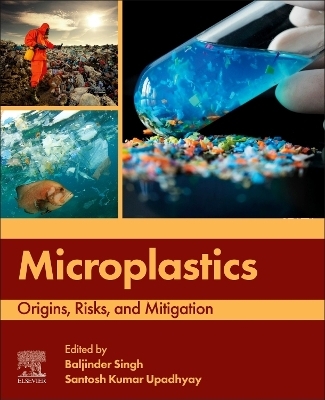
Microplastics
Elsevier - Health Sciences Division (Verlag)
978-0-443-29804-2 (ISBN)
Dr. Baljinder Singh is working as an Associate Professor, Department of Biochemistry, Central University of Punjab, Bathinda, India. He perused his master’s degrees in biotechnology from Punjabi University, Patiala. He completed his Ph.D. from Panjab University, Chandigarh. His research has focused primarily on Applied microbial and plant Biotechnology and Environmental Biotechnology with main emphasis on microbial remediation of pollutants, Biofuel production, and Effluent treatment technology, microplastic contamination in soil and its effect on plants. He has published nearly 53 articles/review papers in journals/books of international repute. He delivered several invited lectures in the institutes of national repute. He had enveloped e-content and delivered seven modules (Lectures) in the field of Environmental Nanotechnology for the paper NanoBiotechnology, under epgPathshala project of MHRD, Govt. of India. Dr. Upadhyay is currently working as an Assistant Professor at the Department of Botany, Panjab University, Chandigarh, India. He has been working in the field of Plant Biotechnology for more than 16 years. He is currently working in functional genomics. His research group at PU has characterized numerous important defence-related protein families such as receptor-like kinases, antioxidant enzymes, calcium transporters, chitinases, lectins, etc. They are also characterizing long non-coding RNAs related to the abiotic and biotic stress response. He has authored more than 130 publications including research papers in leading journals of international repute, national and international patents, book chapters and books. He has been awarded the NAAS Young scientist award (2017-18) and NAAS-Associate (2018) from the National Academy of Agricultural Sciences, India, INSA Medal for Young Scientist (2013) from the Indian National Science Academy, India, NASI- Young Scientist Platinum Jubilee Award (2012) from the National Academy of Sciences, India, and Altech Young Scientist Award (2011).
Section I Introduction Chapter 1: Microplastics contamination in soil, water, air, and environmental health risk assessment Chapter 2: Microplastics in the food chain Section II Microplastics interactions with terrestrial environment and aquatic environment Chapter 3: Toxic effects of micro and nanoplastics on living system and recent advances in understanding their degradation route Chapter 4: Microplastics in soil—uptake, fate, transport, and effect on the growth of plants Chapter 5: Microplastics: toxicity and tolerance in plants Chapter 6: Effect of microplastics on the biochemistry of plant Chapter 7: Microplastics in the atmosphere: transportation and impact on humans Chapter 8: Microplastics contamination in marine system Chapter 9: Microplastics toxicity in aquatic animals Chapter 10: Effects of microplastics on coastal planktonic community Section III Microplastics contaminations: Recent advances and future prospective Chapter 11: Conventional and advanced management techniques and policies adopted at the global level for microplastics Chapter 12: Microplastics and toxic leachate from littered cigarette butts threaten the environment, biodiversity, and human well-being Chapter 13: Challenges associated with preventive measures and environmentally acceptable techniques to control microplastics Chapter 14: Future trends that can be used for MP removals Chapter 15: Bioplastics/biodegradable plastics: a sustainable approach to plastic and their waste management Chapter 16: Microplastics: impact on marine animals and their remediation strategies Chapter 17: Effect of microplastics on seed storage proteins of plants Chapter 18: Various conventional and advanced management techniques and policies adopted at the global level for microplastics Chapter 19: Challenges associated with preventive measures and environmentally acceptable techniques to control microplastics Chapter 20: Microplastics occurrence, contamination, and effects on human health—a critical review Chapter 21: Impact of microplastics on economic condition in underdeveloped nations Chapter 22: Chemical, physical, and biological techniques to remove microplastics
| Erscheinungsdatum | 29.10.2024 |
|---|---|
| Verlagsort | Philadelphia |
| Sprache | englisch |
| Maße | 191 x 235 mm |
| Gewicht | 450 g |
| Themenwelt | Naturwissenschaften ► Biologie ► Ökologie / Naturschutz |
| Technik ► Umwelttechnik / Biotechnologie | |
| ISBN-10 | 0-443-29804-1 / 0443298041 |
| ISBN-13 | 978-0-443-29804-2 / 9780443298042 |
| Zustand | Neuware |
| Haben Sie eine Frage zum Produkt? |
aus dem Bereich


